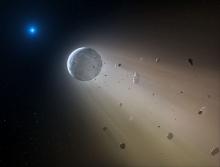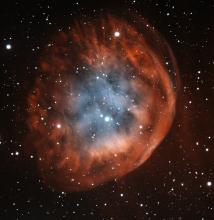Listen to today's episode of StarDate on the web the same day it airs in high-quality streaming audio without any extra ads or announcements. Choose a $8 one-month pass, or listen every day for a year for just $30.
You are here
Bright Merger
When two stars come together, the result can be spectacular. Twenty years ago today, for example, astronomers observed a brilliant eruption in Monoceros, the unicorn. It probably was triggered by the merger of two stars. At its peak, the outburst was a million times brighter than the Sun.
The system is known as V838 Monocerotis. It’s about 20,000 light-years from Earth. It’s on the rim of the Milky Way Galaxy, in its outermost spiral arm. And it appears to belong to a small cluster of bright, heavy stars.
The system became famous a couple of years after the outburst thanks to Hubble Space Telescope. Its pictures showed a brilliant red star surrounded by rings that looked like puffs of cotton candy. The rings weren’t related to the stars, though. Instead, they were clouds of dust around the stars that were being lit up by the eruption.
V838 Mon originally consisted of at least three stars. Two of them were especially big — roughly eight times the mass of the Sun. The third star was only about a third the Sun’s mass. And on January 6th of 2002, as viewed from Earth, the small star appears to have plowed into one of the bigger ones. That triggered the eruption — a spectacular lightshow from a pair of merging stars.
Monoceros climbs into view in the east and southeast by about 8 p.m., to the lower left of Orion. The unicorn is quite faint, though, so you need dark skies to see it.
More about the unicorn tomorrow.
Script by Damond Benningfield






